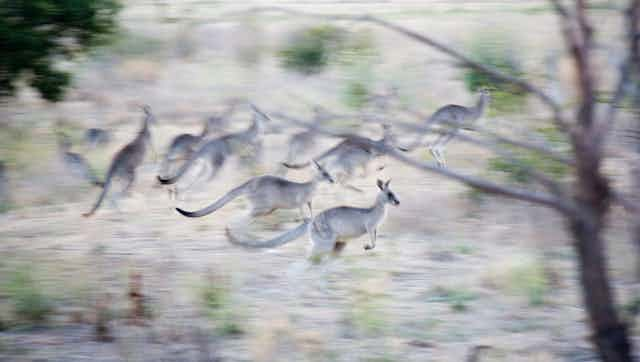Recently there has been a renewed push to expand Australia’s kangaroo meat industry. Queensland Senator Barry O'Sullivan in February raised a Senate motion to support the kangaroo industry and just last week led a delegation to China to expand the export market.
O'Sullivan and the industry claim that the commercial kangaroo industry provides jobs for struggling regional centres. According to the Kangaroo Industry Association of Australia, kangaroo meat provides 4,000 full time jobs and generates A$250-280 million to the economy.
But there has never been a comprehensive economic analysis of the worth of the industry. In a recent paper published in published in Ecological Economics, we show that the industry is worth far less than the industry states.
And that’s not including the costs of killing kangaroos, such as the value of kangaroos to the tourism industry. Therefore we argue that we need to regulate the industry in a new way that accounts for these costs.
The kangaroo economy
Kangaroos are an iconic species belonging to the family Macropodidae, which also includes wallabies, tree-kangaroos, pademelons and the quokka. The family is critical to ecosystem health as animals fertilise nutrient-poor soils and spread the seeds of native grasses and plants, and they are a major draw-card for international tourists.
Despite this, 1.61 million adult kangaroos were killed in 2012 to provide domestic and export products such as meat for human or animal consumption, and hides and skins for the production of leather goods.
How many jobs?
The employment and value numbers have never been justified and have never been revised downwards despite, for example, government figures showing that the value of kangaroo exports fell by A$52.6 million or 53% between 2007 and 2012. This reduction occurred when the export market to the Russian Federation closed due to hygiene and animal welfare concerns.
The 4,000 jobs figure has further been promoted recently by Senator O’Sullivan who cites the kangaroo industry stating that the opening of the China market would add an additional 4,000 jobs.
In our recently published study on the economics of the kangaroo industry we attempted to replicate the industry’s figures but were unable to do so.
Using data gathered by the Rural Industries Research and Development Corporation, and valuing domestic supply at export prices (due to data limitations), we estimated the value of the industry at A$88.8 million in 2011-12.
Moreover, we suggested, generously, that given the Australian economy employs around 10 workers per million dollars of output (when both direct and indirect labour is considered), the total employment supported by the commercial kangaroo industry is 888 full-time equivalent jobs.
This is generous because some industries in Australia employ far more workers per million dollars of output than others. For example, the healthcare sector creates 9.95 direct jobs per million dollars of output while the mining sector creates 1.04 direct and 3.56 direct and indirect jobs per million dollars.
In fact, using Australian Bureau of Statistics input-output tables and 2008-9 figures, the hunting, fishing and trapping industry directly employs only 3.8 workers per million dollars of output. Using this figure, total direct (full-time equivalent) employment in the kangaroo industry is only 337 people.
This suggests that for the sake of jobs, the government would be better served by focusing its attention on industries that have a high labour requirement.
There are costs as well
But it is not just the overstated benefits that concern us as economists. In Economics 101 we teach students that an economic justification requires a comparison of benefits and costs.
In contrast, the Senator’s motion and industry’s focus on employment numbers considers only the benefits of the industry. If we truly wanted to expand jobs at any cost, we could expand the whaling or sealing industry, overfish our endangered marine species and log the country’s old-growth forests as well.
Thus, we need to balance the actual (and transparently-derived) economic benefits with the costs. For example, these costs could include potential negative effects on ecotourism. But commercial harvesting of kangaroos creates an external cost on anyone concerned with conservation and animal protection or anyone who feels an obligation to protect these iconic species. An external cost occurs when producing or consuming a good or service imposes a cost upon a third party.
Processors and exporters have never been required to pay for this cost. This creates an implicit subsidy, which is a cost that processors and exports should pay but don’t have to. Similarly, the absence of carbon pricing creates an implicit subsidy for coal-fired power plants.
We suggest that the way forward is to allow all concerned citizens of the world to have a say in the industry by using a tradeable permit scheme. Processors, shooters, ecotourism operators and ordinary citizens would be able to purchase the right to the kangaroo harvest from landholders. For instance, this would allow ecotourism operators to purchase a permit to reduce the killing of kangaroos and wallabies. Tradeable poermit systems are commonly used in both fisheries and carbon markets amongst other industries.
At the moment, the small number of processors and exporters pay only for the labour and capital resources needed to shoot, transport and process a kangaroo carcass.
Under this new regime, processors and exporters would need to compete with other legitimate interests, such as conservationists and animal protection advocates, for the right to harvest kangaroos.
This would result in the costs discussed above being factored into the decision to harvest kangaroos and the industry would achieve a more socially optimal level. The future of the industry would then be determined by what is good for everyone.

